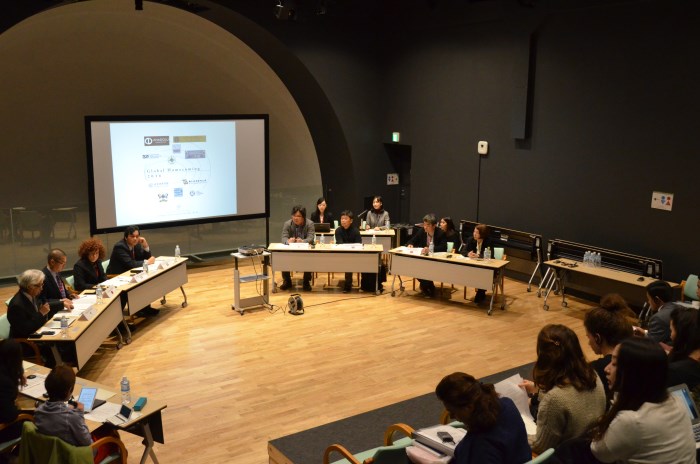「Global Homecoming 2016」フォーラムの開催Global Homecoming Forum 2016
March 10, 2017
12月20日、Arts & Science LAB. 4階にて「Global Homecoming 2016」の一環として、本学に留学経験があり、現在母国の芸術系大学で教鞭を執る元留学生の教員6名を迎え、「藝大で学ぶということ」をテーマとするフォーラムを開催しました。
「おかえりなさい!」。三田村学長特命(国際交流・留学生担当)の歓迎の言葉で幕を開けたフォーラムは、「開学130周年を来年に控えた東京藝術大学のさらなる発展のためには大学を主体とした同窓生や交流協定校との関係強化が重要です。そのために世界各地で活躍する元留学生との交流を活性化し、持続的な人的ネットワークを築いていきたいと考えてこの『グローバル・ホームカミング2016』を開催しました」との趣旨説明、井谷グローバルサポートセンター特任教授による「藝大の国際交流の現状」についての報告に続いて、4つの議題について協議しました。

(左)開会の挨拶をする三田村学長特命 /(右)藝大の国際交流の近況を紹介する井谷特任教授
議題1.「藝大で学ぶ意義、藝大教育の特徴」では、元藝大留学生としての立場で藝大で教育を受けることの意義を語り合いました。
Nipan ORANNIWESNA講師は「藝大は伝統を守ってきた上で、現代的なものとのバランスもとれていると思う。Arts & Science LAB.などの見学を通じてこの思いが強くなり、これからもっと藝大が面白くなりそうだと思った」と語り、自分が教鞭を執る大学でもこの価値観を取り入れていきたいと意欲を示しました。
宋璽德准教授は「デザイン科を初めて訪れたときは学生作品のレベルの高さにショックを受けたが、学びの起爆剤になった。藝大はこれからもアジアを牽引していく存在であり続けてほしい」と期待を語りました。
議題2.「留学の意義」では、藝大に限らず、留学一般の意義について協議しました。
権柱翰教授は「自国では失伝した伝統的な鋳金技法を学べる大学を探して藝大へ留学した。専門用語などの知識が求められる修士・博士課程の入学試験は今までで一番頑張ったときであり、この努力こそが留学の意義だ」と述べました。
陳秋荣教授は「母国で教員となった後に留学した。藝大での研究生時代は朝6時から夜10時まで制作に取り組んだ。母国とは異なる色々な技法を学ぶことができ、得たものは大きかった」と話しました。
議題3.「外部から藝大への関わり方」では、所属大学の教員としての立場で今後藝大と交流を深めていこうとするときの交流方法について提案しました。
Rosaria IAZZETTA教授はヨーロッパ域内外を結ぶ交流プログラム「エラスムス+」活用を提案するとともに、「アーティスト・批評家など全体のネットワークづくりのために、国際会議開催へ動きたい」と意欲を示しました。
Maung Maung Zaw Htet教授からは「教育的要素を含んだコンサートのプロデュースの仕方を藝大から学んで自国で実践したい」「学生に限らず教員を含めた交換留学を行いたい」といった展望が語られました。
また、今回「Global Homecoming 2016」開催に合わせて招聘した「大学の世界展開力」の協力相手先大学の学生らに本事業への参加を通じて感じたことを含めて意見を求めると「藝大には自分専用のスペースで、時間をふんだんに使って制作ができる環境がある」といった評価や「もっと学生を取り込んで国際交流をしてほしい」といった要望がありました。
議題4.「藝大への提言」では、国際交流の強化を求める提言が数多くありました。交換留学により異なる文化を相互に取り入れる、イベントなどによって様々な国から多くの学生や同窓生を招いて互いに学ぶ機会を作るなど直接的な人の交流や、卒業・修了展を海外で見ることができるようにすることで海外の学生が感銘を受け励みになるのではないかといった交流方法の提案が寄せられたほか、卒業証明書の発行をもっと早く行えるようにして欲しいといった事務的なサポート面についても要望がありました。
元留学生の先生方
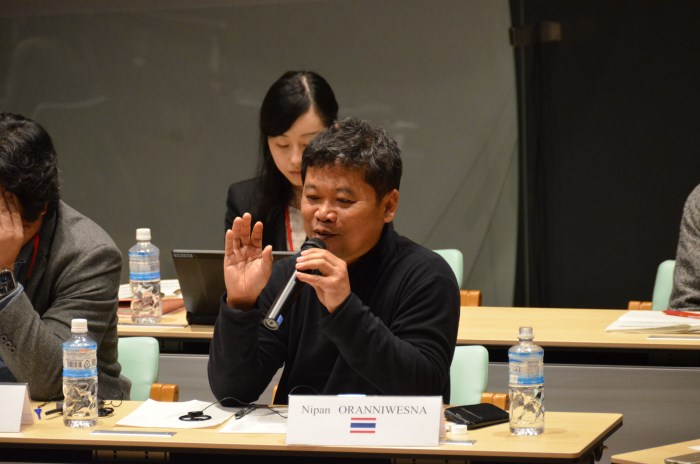
Nipan ORANNIWESNA
タイ/バンコク大学講師
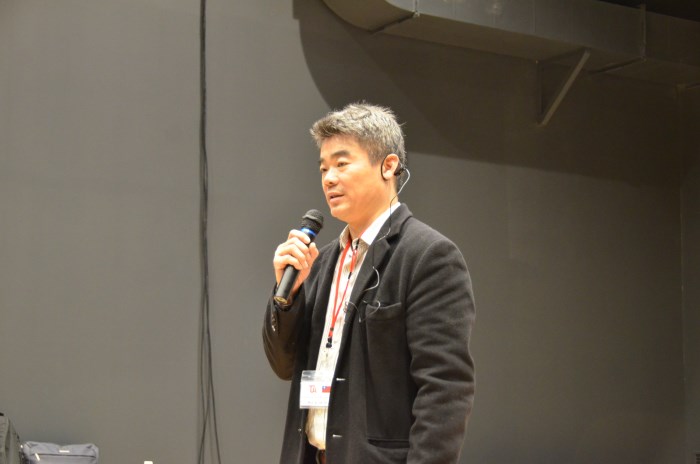
宋璽德
台湾/台湾芸術大学准教授
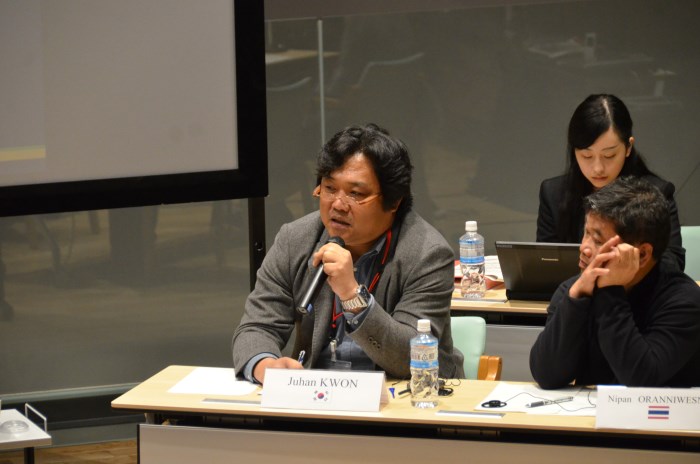
権柱翰
韓国/大邱大学校教授
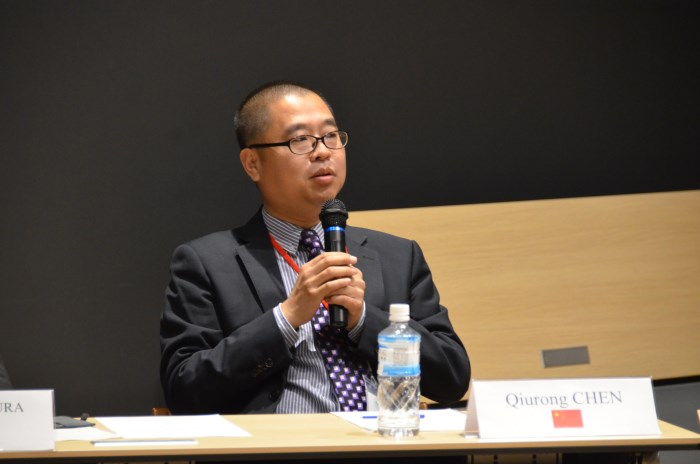
陳秋荣
中国/北京城市学院教授
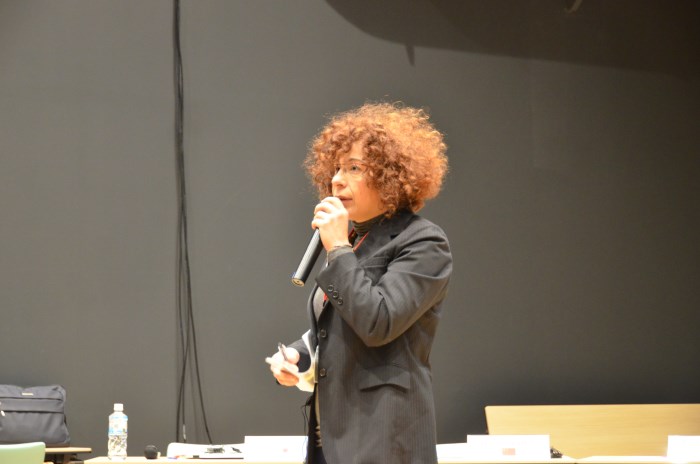
Rosaria IAZZETTA
イタリア/ナポリ美術アカデミア教授
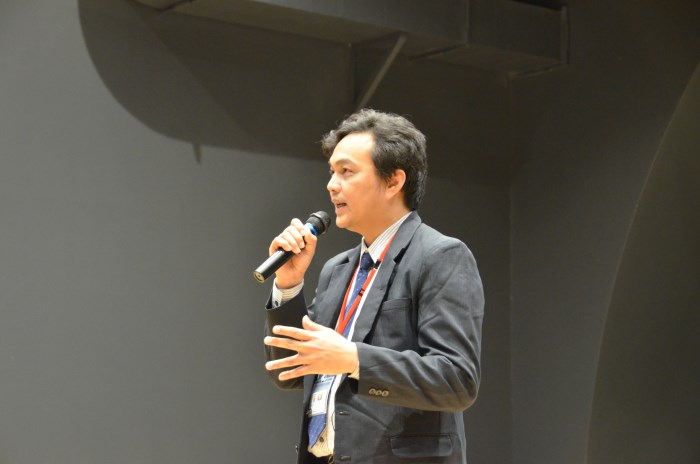
Maung Maung Zaw Htet
ミャンマー/ミャンマー国立文化芸術大学教授
協議を終え、光井副学長より多くの意見が出されたことへの感謝と一方的に学ぶのではなく、藝大と海外の大学の両方が交流し合うことで、藝大が新しいものを作っていく場になることへの期待が述べられました。
最後に、「藝大で学んだ留学生が本国に戻って教育活動をされているということは本学にとって宝です。ローカルとグローバルの間で芸術が果たす役割は大きく、藝大が果たすべき使命は日本に限らず世界においても大きくなっていくと思います。同時に、皆さんの大学が持つ役割も大きくなっていくと思います。そして今回のこの小さな交流が大きな役割になっていくと思います。この『Global Homecoming』がこれからも長く続き、お互いに頑張っていけるようにしていきたいと考えています」との長嶌グローバルサポートセンター運営委員会副委員長の挨拶でフォーラムは幕を閉じました。
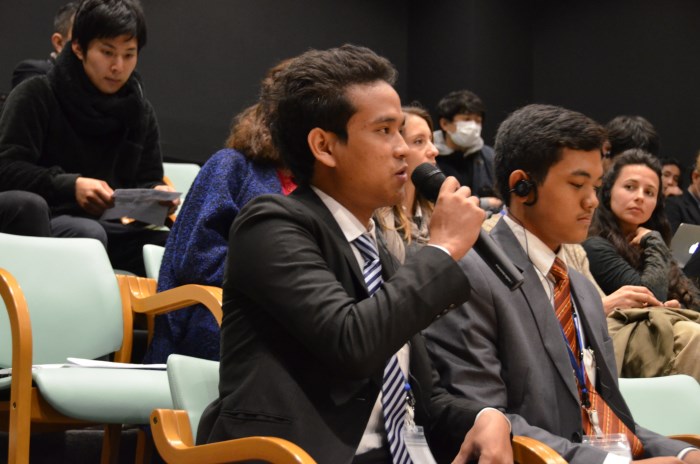
意見を述べる「大学の世界展開力」の協力相手先大学の学生
On December 20, 2016, a forum to discuss the theme of “Studying abroad at Geidai (TUA)” took place, as part of the Global Homecoming 2016 event, on the 4th floor of the Arts & Science LAB. The discussants were six former international students who now teach at art institutions in their home countries.
“Welcome back!” The forum opened with the welcome words of Professor Arisumi Mitamura, who serves as the executive assistant to the President in charge of international exchanges and overseas students. Professor Mitamura continued ” TUA, which will mark the 130th anniversary next year, needs to take proactive approaches to strengthen the ties with its alumni and partner institutions so that it can further develop. This is why we organized “Global Homecoming 2016” to increase communication with former international students, who are now actively working all over the world, thereby establishing a sustained network of people”. Following the explanation by Project Professor Yoshie Itani of the Global Support Center on the current situation of international exchanges at TUA, the discussion on the four sub-themes began.

Left: Prof. Mitamura delivering opening remarks
Right: Prof. Itani talking about current international exchanges at TUA
Sub-theme 1: Meaning of studying at Geidai
In this session, the discussants talked about the significance of studying at TUA as international students.
Lecturer Nipan Oranniwesna commented that TUA is well balanced in terms of maintaining traditional aspects and assimilating modern aspects. He said that after visiting its latest facilities such as Arts & Science LAB., he was convinced that TUA would be more and more exciting. Lecturer Oranniwesna showed a willingness to take in the value possessed by TUA for the university he is currently teaching.
Associate professor Hsi-Te Sung admitted that he was quite shocked at the level of student works when he first visited TUA’s design department, and said that the shock made him study even harder. He showed an expectation that TUA would keep serving as a leader of art universities in the Asian region.
Sub-theme 2: Importance of studying abroad
The second discussion covered the significance of studying abroad in general.
Professor Juhan Kwon explained that he came to study at TUA because he wanted to learn traditional metal casting techniques that were lost in his country. “I made the greatest efforts in my life when I took the entrance examinations for the master’s and doctoral programs, as I needed to have special knowledge including technical terms. To me, these efforts were the very significance of studying abroad. ” he recalled.
Professor Qiurong Cheng said “I came to study in Japan after becoming a teacher in my home country. During my days as a research student at TUA, I focused on creating art works from 6 a.m. to 10 p.m. I learned various techniques which were different from what were available back in China, and what I gained through this experience meant a lot to me”.
Sub-theme3: Engagements and Collaborations with Geidai (TUA)
In the third session, the discussants made proposals on how to promote international exchanges with TUA as the academic staff members of their respective institutions.
Professor Rosaria Iazzetta proposed the use of “Erasmus+”, the EU’s exchange program that links countries both in and out of Europe. She also showed a willingness to start organizing an international conference with a view to establishing a general network of artists and critics.
Professor Maung Maung Zaw Htet talked about his vision to learn from TUA how to produce a concert that includes educational elements and actually hold such concerts in his home country. He also said that he is willing to have exchange programs not only for students but also for faculty staff.
In addition, students from some of the institutions that TUA partnered with under the Re-inventing Japan project, who were also invited to Global Homecoming, were asked their opinions and impressions about their participation in the event. A student said “TUA has an environment where students can spend plenty of time to work in the space individually allotted to them”. Another student requested that TUA should involve students more in its international exchange activities.
Sub-theme 4: Proposals for Geidai
Many proposals were made during this session that TUA should work more with overseas institutions. One proposed way was direct human exchanges, where TUA implements exchange programs to promote mutual learning of different cultures, or holds events for students and former students from different countries to mingle with TUA students. Other opinions included that TUA should hold graduation exhibitions overseas as well, where local students can be inspired and encouraged by TUA students’ works. Furthermore, there were some requests for improving administrative procedures such as more prompt issuing of graduate certificate.

Nipan ORANNIWESNA, Bangkok University, Thailand

Hsi-Te SUNG, National Taiwan University of Arts, Taiwan

Juhan KWON, Daegu University, South Korea

Qiurong CHEN, Beijing City University, China

Rosaria IAZZETTA , Naples Academy of Fine Arts, Italy

Maung Maung Zaw Htet, National University of Arts and Culture(Yangon), Myanmar
When all the sessions were over, TUA’s Vice President Wataru Mitsui thanked the participants for giving many opinions. He showed an expectation that TUA would serve as a place where new things would be created through collaboration with overseas partner universities, rather than learning from them one-sidedly.
The forum was concluded with a speech by Professor Hiroyuki Nagashima, who is also a representative of the Global Support Center. “TUA treasures the international students who studied at TUA and are now engaged in educational activities in their home countries. Art plays an important role in between “local” and “global”, and accordingly, TUA will be required to accomplish larger missions not only in Japan but also in the world. At the same time, your universities will also be expected to play larger roles. I assume this exchange event, though it is still small, will also play a bigger role in the future. TUA will see to it that the Global Homecoming event will continue for a long time, allowing us to stay committed to making combined efforts”.



